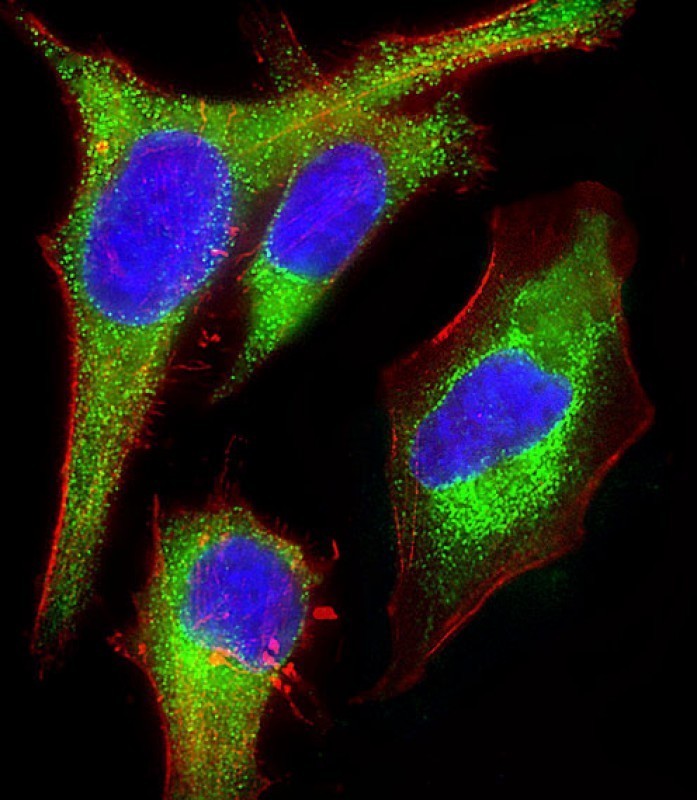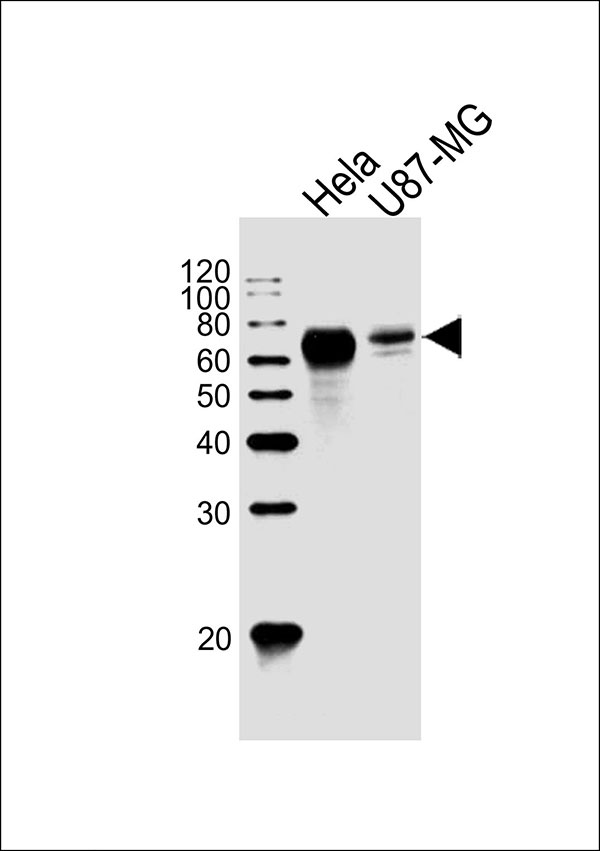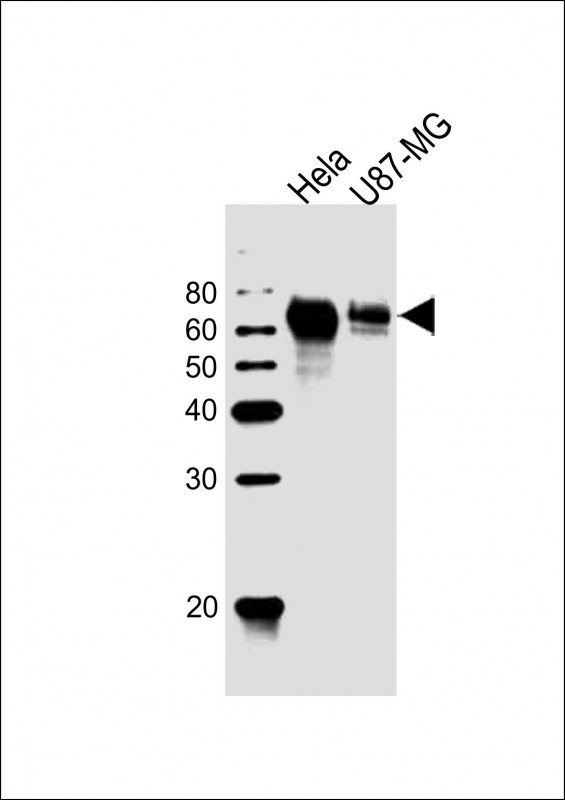GPR56 Antibody
Purified Mouse Monoclonal Antibody (Mab)
- SPECIFICATION
- CITATIONS
- PROTOCOLS
- BACKGROUND

Application
| WB, IF |
|---|---|
| Primary Accession | Q9Y653 |
| Reactivity | Human |
| Host | Mouse |
| Clonality | Monoclonal |
| Calculated MW | H=78,77,59,58 KDa |
| Isotype | IgG1,k |
| Antigen Source | HUMAN |
| Gene ID | 9289 |
|---|---|
| Other Names | G-protein coupled receptor 56, Protein TM7XN1, GPR56 N-terminal fragment, GPR56 NT, GPR56(N), GPR56 extracellular subunit, GPR56 subunit alpha, GPR56 C-terminal fragment, GPR56 CT, GPR56(C), GPR56 seven-transmembrane subunit, GPR56 7TM, GPR56 subunit beta, GPR56, TM7LN4, TM7XN1 |
| Dilution | WB~~1:1000 IF~~1:25 |
| Target/Specificity | This antibody is generated from a mouse immunized with a recombinant protein. |
| Format | Purified monoclonal antibody supplied in PBS with 0.09% (W/V) sodium azide. This antibody is purified through a protein G column, followed by dialysis against PBS. |
| Storage | Maintain refrigerated at 2-8°C for up to 2 weeks. For long term storage store at -20°C in small aliquots to prevent freeze-thaw cycles. |
| Precautions | GPR56 Antibody is for research use only and not for use in diagnostic or therapeutic procedures. |
| Name | ADGRG1 {ECO:0000303|PubMed:26710850, ECO:0000312|HGNC:HGNC:4512} |
|---|---|
| Function | Adhesion G-protein coupled receptor (aGPCR) for steroid hormone 17alpha-hydroxypregnenolone (17-OH), which is involved in cell adhesion and cell-cell interactions (PubMed:39389061). Ligand binding causes a conformation change that triggers signaling via guanine nucleotide-binding proteins (G proteins) and modulates the activity of downstream effectors, such as RhoA pathway (PubMed:28874577, PubMed:35418682, PubMed:39389061). ADGRG1 is coupled to G(12) and/or G(13) G proteins (GNA12 and GNA13, respectively) and mediates the activation Rho small GTPases (PubMed:22238662, PubMed:28424266, PubMed:35418682, PubMed:39389061). Acts as a potent suppressor of ferroptosis: binding to 17-OH-binding initiates signaling that down- regulates CD36 and alleviates ferroptosis-induced liver injury (By similarity). Ligand-binding also induces cell adhesion activity via association with proteins such as collagen III/COL3A1 and TGM2 (By similarity). Mediates cell matrix adhesion in developing neurons and hematopoietic stem cells (By similarity). Involved in cortical development, specifically in maintenance of the pial basement membrane integrity and in cortical lamination: association with COL3A1 in the developing brain inhibits neuronal migration via activation of the RhoA pathway (PubMed:24531968). Together with TGM2, acts as a regulator of myelination and myelin repair in oligodendrocyte precursor cells (By similarity). Acts as a hemostatic sensor of shear force: G protein- coupled receptor signaling is activated in response to shear force in platelets, promoting G(13) G protein signaling, and platelet shape change and aggregation in a COL3A1-dependent manner (PubMed:33097663). Acts as an inhibitor of VEGFA production thereby inhibiting angiogenesis through a signaling pathway mediated by PRKCA (PubMed:16757564, PubMed:19572147, PubMed:21724588). Plays a role in the maintenance of hematopoietic stem cells in bone marrow niche (By similarity). Plays an essential role in testis development (By similarity). |
| Cellular Location | Cell membrane; Multi-pass membrane protein [Adhesion G-protein coupled receptor G1, C- terminal fragment]: Membrane raft Note=Interaction with its ligand COL3A1 leads to the release of ADGRG1 NT from the membrane and triggers the association of ADGRG1 CT with lipid rafts. |
| Tissue Location | Widely distributed with highest levels found in thyroid gland, brain and heart. Expressed in a great number of tumor cells. Expression is down-regulated in different tumors from highly metastatic cells. |

Thousands of laboratories across the world have published research that depended on the performance of antibodies from Abcepta to advance their research. Check out links to articles that cite our products in major peer-reviewed journals, organized by research category.
info@abcepta.com, and receive a free "I Love Antibodies" mug.
Provided below are standard protocols that you may find useful for product applications.
Background
Involved in cell adhesion and probably in cell-cell interactions. Regulates the migration of neural precursor cells. Receptor for collagen III/COL3A1 in the developing brain and involved in regulation of cortical development, specifically in maintenance of the pial basemant membrane integrity and in cortical lamination. Binding to the COL3A1 ligand inhibits neuronal migration and activates the RhoA pathway by coupling to GNA13 and possibly GNA12. Isoforms show differences in receptor signaling, specifically in serum response element (SRE) transcriptional activation upon overexpression. Overexpression inhibits melanoma tumor growth and metastasis and, during melanoma progression, regulates VEGFA production and angiogenesis through PRKCA; unprocessed GPR56 is inhibiting and GPR56 NT is activating angiogenesis.
References
Liu M.,et al.Genomics 55:296-305(1999).
Zendman A.J.W.,et al.FEBS Lett. 446:292-298(1999).
Kaighin V.A.,et al.Submitted (DEC-2007) to the EMBL/GenBank/DDBJ databases.
Clark H.F.,et al.Genome Res. 13:2265-2270(2003).
Ota T.,et al.Nat. Genet. 36:40-45(2004).
If you have used an Abcepta product and would like to share how it has performed, please click on the "Submit Review" button and provide the requested information. Our staff will examine and post your review and contact you if needed.
If you have any additional inquiries please email technical services at tech@abcepta.com.













 Foundational characteristics of cancer include proliferation, angiogenesis, migration, evasion of apoptosis, and cellular immortality. Find key markers for these cellular processes and antibodies to detect them.
Foundational characteristics of cancer include proliferation, angiogenesis, migration, evasion of apoptosis, and cellular immortality. Find key markers for these cellular processes and antibodies to detect them. The SUMOplot™ Analysis Program predicts and scores sumoylation sites in your protein. SUMOylation is a post-translational modification involved in various cellular processes, such as nuclear-cytosolic transport, transcriptional regulation, apoptosis, protein stability, response to stress, and progression through the cell cycle.
The SUMOplot™ Analysis Program predicts and scores sumoylation sites in your protein. SUMOylation is a post-translational modification involved in various cellular processes, such as nuclear-cytosolic transport, transcriptional regulation, apoptosis, protein stability, response to stress, and progression through the cell cycle. The Autophagy Receptor Motif Plotter predicts and scores autophagy receptor binding sites in your protein. Identifying proteins connected to this pathway is critical to understanding the role of autophagy in physiological as well as pathological processes such as development, differentiation, neurodegenerative diseases, stress, infection, and cancer.
The Autophagy Receptor Motif Plotter predicts and scores autophagy receptor binding sites in your protein. Identifying proteins connected to this pathway is critical to understanding the role of autophagy in physiological as well as pathological processes such as development, differentiation, neurodegenerative diseases, stress, infection, and cancer.




